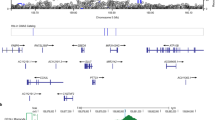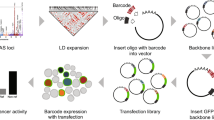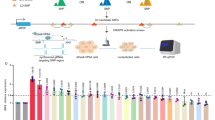Abstract
Linkage disequilibrium poses a major challenge to the functional characterization of specific disease-associated susceptibility variants. Precision genome-editing technologies have provided new opportunities to address this challenge. As proof of concept, we employed TALEN (transcription activation-like effector nuclease)-mediated genome editing to specifically disrupt the TT>A enhancer region to mimic candidate causal variants identified in the systemic lupus erythematosus-associated susceptibility gene, tumor necrosis factor-α-induced protein 3 (TNFAIP3), in an isogenic HEK293T cell line devoid of other linkage disequilibrium-associated variants. Targeted disruption of the TT>A enhancer impaired its interaction with the TNFAIP3 promoter by long-range DNA looping, thereby reducing TNFAIP3 gene expression. Loss of TNFAIP3 mRNA and its encoded protein, A20, impaired tumor necrosis factor-α-induced receptor-mediated downregulation of nuclear factor-κB signaling, a hallmark of autoimmunity. Results demonstrate that the TT>A enhancer variants contribute to causality and function independently of other variants to disrupt TNFAIP3 expression. Furthermore, we believe this approach can be implemented to independently examine other candidate casual variants in the future.
This is a preview of subscription content, access via your institution
Access options
Subscribe to this journal
Receive 6 digital issues and online access to articles
$119.00 per year
only $19.83 per issue
Buy this article
- Purchase on SpringerLink
- Instant access to full article PDF
Prices may be subject to local taxes which are calculated during checkout





Similar content being viewed by others
References
Cui Y, Sheng Y, Zhang X . Genetic susceptibility to SLE: recent progress from GWAS. J Autoimmun 2013; 41: 25–33.
Relle M, Weinmann-Menke J, Scorletti E, Cavagna L, Schwarting A . Genetics and novel aspects of therapies in systemic lupus erythematosus. Autoimmun Rev 2015; 14: 1005–1018.
Adrianto I, Wang S, Wiley GB, Lessard CJ, Kelly JA, Adler AJ et al. Association of two independent functional risk haplotypes in TNIP1 with systemic lupus erythematosus. Arthritis Rheum 2012; 64: 3695–3705.
Wang S, Adrianto I, Wiley GB, Lessard CJ, Kelly JA, Adler AJ et al. A functional haplotype of UBE2L3 confers risk for systemic lupus erythematosus. Genes Immun 2012; 13: 380–387.
Graham RR, Cotsapas C, Davies L, Hackett R, Lessard CJ, Leon JM et al. Genetic variants near TNFAIP3 on 6q23 are associated with systemic lupus erythematosus. Nat Genet 2008; 40: 1059–1061.
Bentham J, Morris DL, Cunninghame Graham DS, Pinder CL, Tombleson P, Behrens TW et al. Genetic association analyses implicate aberrant regulation of innate and adaptive immunity genes in the pathogenesis of systemic lupus erythematosus. Nat Genet 2015; 47: 1457–1464.
Ma A, Malynn BA . A20: linking a complex regulator of ubiquitylation to immunity and human disease. Nat Rev Immunol 2012; 12: 774–785.
Lee EG, Boone DL, Chai S, Libby SL, Chien M, Lodolce JP et al. Failure to regulate TNF-induced NF-kappaB and cell death responses in A20-deficient mice. Science 2000; 289: 2350–2354.
Tavares RM, Turer EE, Liu CL, Advincula R, Scapini P, Rhee L et al. The ubiquitin modifying enzyme A20 restricts B cell survival and prevents autoimmunity. Immunity 2010; 33: 181–191.
Chu Y, Vahl JC, Kumar D, Heger K, Bertossi A, Wojtowicz E et al. B cells lacking the tumor suppressor TNFAIP3/A20 display impaired differentiation and hyperactivation and cause inflammation and autoimmunity in aged mice. Blood 2011; 117: 2227–2236.
Hovelmeyer N, Reissig S, Xuan NT, Adams-Quack P, Lukas D, Nikolaev A et al. A20 deficiency in B cells enhances B-cell proliferation and results in the development of autoantibodies. Eur J Immunol 2011; 41: 595–601.
Yang W, Tang H, Zhang Y, Tang X, Zhang J, Sun L et al. Meta-analysis followed by replication identifies loci in or near CDKN1B, TET3, CD80, DRAM1, and ARID5B as associated with systemic lupus erythematosus in Asians. Am J Hum Genet 2013; 92: 41–51.
Jostins L, Ripke S, Weersma RK, Duerr RH, McGovern DP, Hui KY et al. Host-microbe interactions have shaped the genetic architecture of inflammatory bowel disease. Nature 2012; 491: 119–124.
Genetic Analysis of Psoriasis Consortium & the Wellcome Trust Case Control Consortium 2, Strange A, Capon F, Spencer CC, Knight J et al. A genome-wide association study identifies new psoriasis susceptibility loci and an interaction between HLA-C and ERAP1. Nat Genet 2010; 42: 985–990.
Kochi Y, Okada Y, Suzuki A, Ikari K, Terao C, Takahashi A et al. A regulatory variant in CCR6 is associated with rheumatoid arthritis susceptibility. Nat Genet 2010; 42: 515–519.
Stahl EA, Raychaudhuri S, Remmers EF, Xie G, Eyre S, Thomson BP et al. Genome-wide association study meta-analysis identifies seven new rheumatoid arthritis risk loci. Nat Genet 2010; 42: 508–514.
Dubois PC, Trynka G, Franke L, Hunt KA, Romanos J, Curtotti A et al. Multiple common variants for celiac disease influencing immune gene expression. Nat Genet 2010; 42: 295–302.
Han JW, Zheng HF, Cui Y, Sun LD, Ye DQ, Hu Z et al. Genome-wide association study in a Chinese Han population identifies nine new susceptibility loci for systemic lupus erythematosus. Nat Genet 2009; 41: 1234–1237.
Musone SL, Taylor KE, Lu TT, Nititham J, Ferreira RC, Ortmann W et al. Multiple polymorphisms in the TNFAIP3 region are independently associated with systemic lupus erythematosus. Nat Genet 2008; 40: 1062–1064.
Plenge RM, Cotsapas C, Davies L, Price AL, de Bakker PI, Maller J et al. Two independent alleles at 6q23 associated with risk of rheumatoid arthritis. Nat Genet 2007; 39: 1477–1482.
Wang S, Wen F, Wiley GB, Kinter MT, Gaffney PM . An enhancer element harboring variants associated with systemic lupus erythematosus engages the TNFAIP3 promoter to influence A20 expression. PLoS Genet 2013; 9: e1003750.
Adrianto I, Wen F, Templeton A, Wiley G, King JB, Lessard CJ et al. Association of a functional variant downstream of TNFAIP3 with systemic lupus erythematosus. Nat Genet 2011; 43: 253–258.
Wright DA, Li T, Yang B, Spalding MH . TALEN-mediated genome editing: prospects and perspectives. Biochem J 2014; 462: 15–24.
Kim Y, Kweon J, Kim JS . TALENs and ZFNs are associated with different mutation signatures. Nat Methods 2013; 10: 185.
Gaj T, Gersbach CA, Barbas CF 3rd . ZFN, TALEN, and CRISPR/Cas-based methods for genome engineering. Trends Biotechnol 2013; 31: 397–405.
Mussolino C, Morbitzer R, Lutge F, Dannemann N, Lahaye T, Cathomen T . A novel TALE nuclease scaffold enables high genome editing activity in combination with low toxicity. Nucleic Acids Res 2011; 39: 9283–9293.
Doyle EL, Booher NJ, Standage DS, Voytas DF, Brendel VP, Vandyk JK et al. TAL Effector-Nucleotide Targeter (TALE-NT) 2.0: tools for TAL effector design and target prediction. Nucleic Acids Res 2012; 40 (Web Server issue): W117–W122.
Dahlem TJ, Hoshijima K, Jurynec MJ, Gunther D, Starker CG, Locke AS et al. Simple methods for generating and detecting locus-specific mutations induced with TALENs in the zebrafish genome. PLoS Genet 2012; 8: e1002861.
Siggers T, Chang AB, Teixeira A, Wong D, Williams KJ, Ahmed B et al. Principles of dimer-specific gene regulation revealed by a comprehensive characterization of NF-kappaB family DNA binding. Nat Immunol 2012; 13: 95–102.
Gilmore TD . Introduction to NF-kappaB: players, pathways, perspectives. Oncogene 2006; 25: 6680–6684.
Sanger F, Coulson AR . A rapid method for determining sequences in DNA by primed synthesis with DNA polymerase. J Mol Biol 1975; 94: 441–448.
Sanger F, Nicklen S, Coulson AR . DNA sequencing with chain-terminating inhibitors. Proc Natl Acad Sci USA 1977; 74: 5463–5467.
Schefe JH, Lehmann KE, Buschmann IR, Unger T, Funke-Kaiser H . Quantitative real-time RT-PCR data analysis: current concepts and the novel "gene expression's CT difference" formula. J Mol Med (Berl) 2006; 84: 901–910.
Acknowledgements
This work was supported by grants from the National Institutes of Health 5 R01 AR056360-05, 5 R01 AR063124-04 and P30 GM110766.
Author information
Authors and Affiliations
Corresponding author
Ethics declarations
Competing interests
The authors declare no conflict of interest.
Additional information
Supplementary Information accompanies this paper on Genes and Immunity website
Supplementary information
Rights and permissions
About this article
Cite this article
Wang, S., Wen, F., Tessneer, K. et al. TALEN-mediated enhancer knockout influences TNFAIP3 gene expression and mimics a molecular phenotype associated with systemic lupus erythematosus. Genes Immun 17, 165–170 (2016). https://doi.org/10.1038/gene.2016.4
Received:
Revised:
Accepted:
Published:
Issue Date:
DOI: https://doi.org/10.1038/gene.2016.4



